BORA BORA TO PALMERSTON: 736 miles
We were warned that the sea state and winds would become more challenging as one headed west across the Pacific, and our first six day crossing from Bora Bora to Palmerston proved that warning to be correct. The majority of the time, we were making 6 or more knots sailing on a third-reefed main and a reefed yankee in 20 to 25 knot winds with 3-meter seas whose period was about six seconds. That is a lot for our little boat; prior to this, our overall boat speed average had been about 4.5 knots, including when we crossed the Pacific from Mexico to French Polynesia. We got our butts kicked! But we were never out of control, just going for one hell of a ride!
After our 27 days at sea from Mexico, I had made no secret of the fact that crossings were not my favorite part of sailing. That was one of the factors we balanced as we decided whether to continue west. I remember distinctly on that crossing from Mexico, one morning after I had been vomiting all night and it was all I could do to muster the energy to stand watch, Rick came on watch to find a line out of place, and he declared that he felt I wasn’t pulling my weight. Of course, he remembers nothing of the incident, but it made me livid. So as part of our discussions of whether to continue west, I laid it out on the line: on crossings, I commit to standing my watch no matter how I am feeling, to making sure we have meals prepared to eat, to monitoring weather and to navigating a safe passage. Consider anything else I do, as icing on the cake. If you find a line out of place after my watch, fix it and let me know, but no scoldings allowed. I will be doing the best I can to the limits of my physical ability.
Well, that commitment was brought to the test our very first night at sea on our crossing from Bora to Palmerston. I am down below in the cabin, helping to relay other boats’ latitude and longitude locations to the net controller for our evening SSB check-in. (There were at least two “nets” we checked into daily on our long distance radio for mutual support. Rick has done such a good job of eliminating causes of interference on our SSB radio that we often find ourselves relaying information between stations who can’t hear each other.). Anyway, I am down below in big seas reading and writing detailed numbers and wham! I was hit with the uncontrollable urge to vomit. I ran into the cockpit and heaved over the side without a second to spare.
And the heaving continued. And continued. For 18 hours, I couldn’t keep anything down, and I couldn’t stand up without throwing up. But I had committed to doing my watch, no matter what. Shit. Well, the answer lie in swapping shifts with Rick: he took my 9 pm to 2 am watch, just for that night, while I tried to recover, and I took his 2 am to 7 am watch. I managed ok; I think I only vomited twice during those five hours! With just two people on board, you simply cannot afford to let one person remain at the helm indefinitely. While it may seem gallant for them to do so, it is jeopardizing the safety of everyone to be that sleep-deprived. So, I stood the f!?king watch! Even with my taking his watch, he was exhausted the next day because of the extra burden it put in him for me not to be 100%.
The next day, it occurred to us that maybe I should take some sea sickness medication, albeit a bit late. I also started drinking electrolite packages I had saved from Mexico. By noon, I was able to start holding food down again, thank goodness. I continued to take the seasickness medication for a few more days, just in case. After five years of cruising, I had thought I had rid myself of the need for sea sickness medication, but apparently not, especially on long passages.
The first 18 hours of the passage was miserable due to getting sea sick, but I think that made the rest of the trip quite comfortable by comparison! I don’t know if Rick and I are just getting used to it or what, and the seas were no less rolly and difficult to maneuver in than the worst of what we have had before, but somehow neither of us found them unmanageable this time. Baby steps, holding on with both hands, never allowing yourself to rush, etc., just became a way of being. Knowing the voyage would end after a week was also nice!
We had already established a number of routines from our Mexico to French Polynesia crossing that we maintained, and others, we changed slightly. We maintained our unforgiving policy of always being tethered to the boat when outside of the cabin. We shortened our night watches from six to five hours, and each of us had an additional three hours to ourselves sometime during the day. We added two, two-hour long dog watches at dawn and dusk. The dog watches are when both of us are on duty, usually with one of us having non-watch duties like radio check or dinner prep. I think we liked our new schedule. We had prepared all of our one-pot dinners in advance, so all that was left to do was heat them up; whoever was down below when dinner time arrived was the one who heated them up.
So here is a little video of what our seas were like for most of the crossing. This video was taken on Day Five.
We had contracted with a weather router to advise us of the best time to leave, but after witnessing the seas and winds he gave us, we wondered if he really understood what we wanted! It was as though he was thinking, the more wind, the better! Some friends had left a few days earlier and motored for the first several days, but ran into weather later. I was all for motoring if we had to, but Rick hates motoring, and we finally came to the conclusion that in the South Pacific trade winds, the best weather you can hope for is enough wind to fill your sails and a fast crossing. Comfort is probably not one of the criteria that is suitable for this area.
So, we lived with 20 knots winds, big swells, and lots of wind chop for most of the six day crossing to Palmerston. The last few days, we had to slow down considerably to arrive in the daylight.
It wasn’t all nail-biting, though. As always, there were moments of bliss that make it all worthwhile. One night on my watch I was at first frightened by a flash in the sky that looked so close I thought it was a mast light. I quickly grabbed my spotlight and shown it on the sails to advise the fantom sailboat I was there, to not hit us! But then nothing. If there had been a boat there, it disappeared as fast as it came. A few minutes later, I saw another flash from the same direction, but this time it was further away and it had a tail. I then realized that the first light had been a falling star, and that I was witnessing, in the blackest of black and clearest of clear nights with no light pollution in the middle of the South Pacific Ocean, the Perseus meteor shower. It was magnificent. Rick saw another six falling stars on his watch. Those kinds of moments make such voyages unforgettable.
We were buddy boating on this crossing, meaning that we had a friend in his boat crossing at the same time as we were on the approximate same course at approximately the same speed. That turned out to have its challenges. While it may be comforting to know that another boat is nearby if we need assistance, it is also a added responsibility to be available to support them if any of their systems go out, and on this trip, they had several critical pieces of equipment fail, including their autopilots. It is also important that whoever you choose to buddy boat with has comparable systems to yours for location identification, especially if they are going to be traveling in close proximity. We transmitted AIS but they didn’t, so they knew where we were but we didn’t know where they were. RADAR readings were confounded by the high sea state. We also learned it is important to communicate clear expectations in advance for how to avoid a collision if your buddy boat intends to sail nearby – we were the stand on vessel but were forced to take evasive action in undesirable conditions at night to avoid a collision with them. Finally, if your buddy boat has inexperienced crew aboard, be prepared for the fact that they may not be relied upon to understand who has right of way or to properly use critical equipment at the time it is needed, like their radio. To sum it all up, buddy boating is not always such a good idea.
And we had a problem of our own: our short range radio (VHF) was not transmitting further than a couple of miles, although it should transmit and receive up to 25 miles. Rick isolated the problem to the antenna cable, which was the original, but didn’t get changed out by the technicians when we asked them to back in San Francisco because they said the cable looked fine. Now we were paying the price. The cable wasn’t completely gone, it just wasn’t operating at 100% capacity. Since both our VHF and our AIS use antennas, Rick had the bright idea of swapping the cable connectors to use the AIS cable/antenna for VHF and vice versa. That gave us a longer VHF range but still allowed for short range AIS transmission and reception. It was a good workaround until we can install a new antenna cable down the mast next season.
PALMERSTON
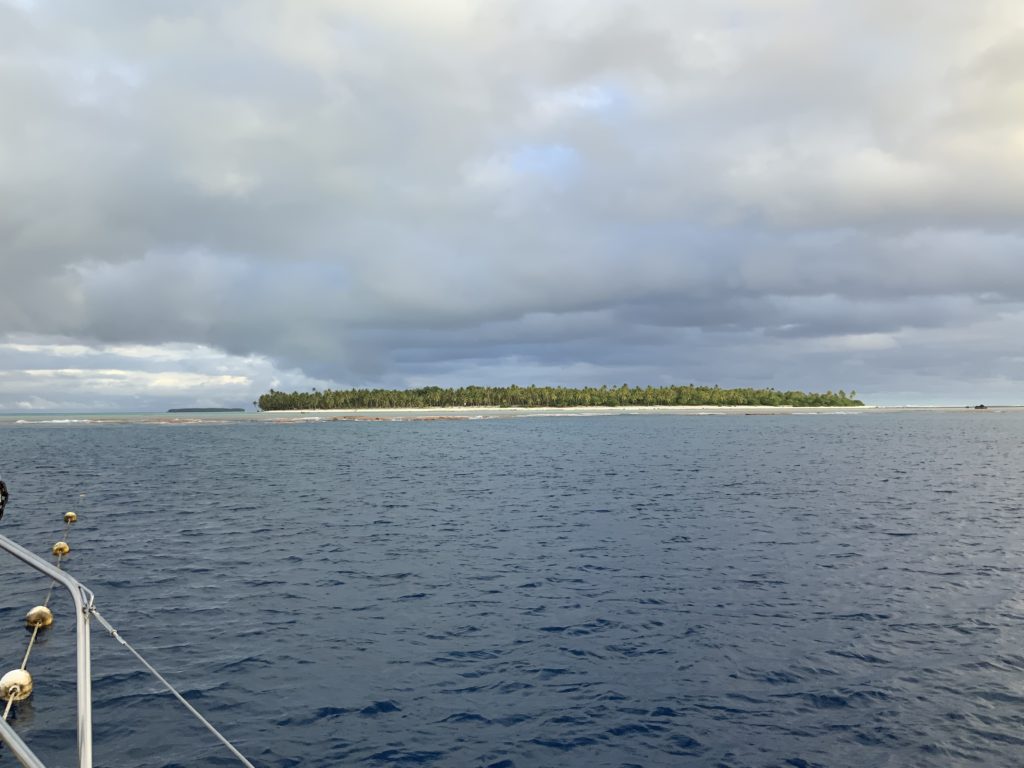
We arrived in Palmerston in the Cook Islands and stayed for a week. If you were to look at Google Earth of the South Pacific, you can see that under the water, the bottom is not flat – it has mountains and valleys. In the South Pacific, most of those mountains are volcanic. And they eventually sink. Well, as you look at the map, and scroll in, you can see that the very tops of some of those underwater mountains are actually above water, but just barely. Those are atolls. Pretty much all of the 15 Cook Islands are atolls, and they are scattered roughly north to south every few hundred miles from each other over 2 million square kilometers. From Palmerston, French Polynesia is 650 miles to the east, Nuie, another small island nation, is 400 miles to the west, and the closest Cook Island is 200 miles southeast from Palmerston.

So, there we were, sailing along, and we come to this little droplet of land surrounded by a reef where 30 or so people of five generations of one family are living! It is the quintessential island paradise, with palm trees and lots of hammocks. Of course, we planned to stop there, but it is still a surprise when you have seen nothing but ocean for six days. An Englishman by the name of Marsters brought his three native wives there 170 years ago and they started a colony that still exists today. It is part of the Cook Islands, mostly supported by New Zealand, but it has significant autonomy. The only real industry there is the export of parrot fish, considered a delicacy.

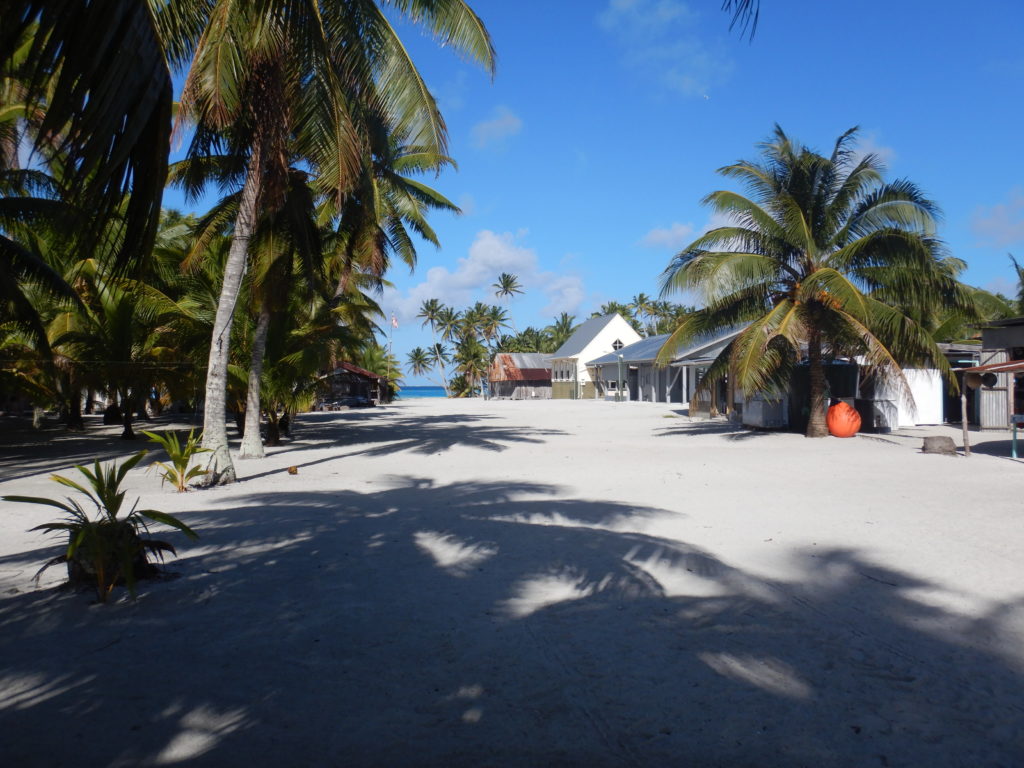
And the families also host yachts on the six moorings they maintain. For $10 per yacht per day, they give us a mooring ball, transport us in their skiffs to and from the island, and feed us a dinner-sized lunch every day, eaten with the family. Rick and I got the extra special treat, unplanned, of arriving during a weeklong Independence Day celebration, so we watched traditional sports games being played, listened to songs in several part harmony in the traditional style, watched hula dancing, and cheered on the fisherman as they competed for catching the biggest fish (the oldest son of our host family caught the biggest, a 51 kilo wahoo), and we got to take some of the fish back to the boat. We joined in on the final celebration, that included a huge feast. The best part was that even though there are three branches of the family based on the three original wives, and we were hosted by just one of the families, the Independence celebration was with the entire island so we got to know some of the folks from the other two families as well. We went to church with everyone on Sunday – luckily I had read ahead of time that I needed to wear a long dress with sleeves and a straw hat to church, out of respect. The minister said during the sermon that we had been there long enough that we could now be considered Palmerstonians!
As Rick noted, “our visit to Palmerston started with us getting a wild ride through the reef pass on our host’s launch into the lagoon. The water was very shallow and had stick markers where the rocks and corals are, but he needed to go fast to keep the boat high enough in the water. This was definitely an “e” ticket ride.”
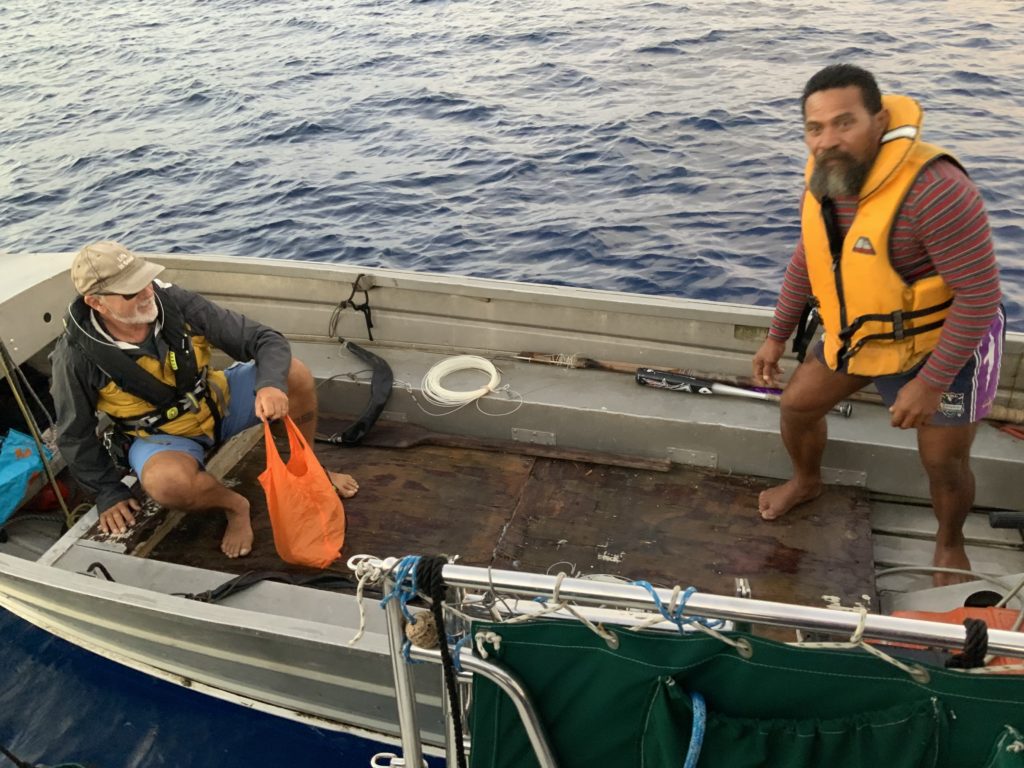
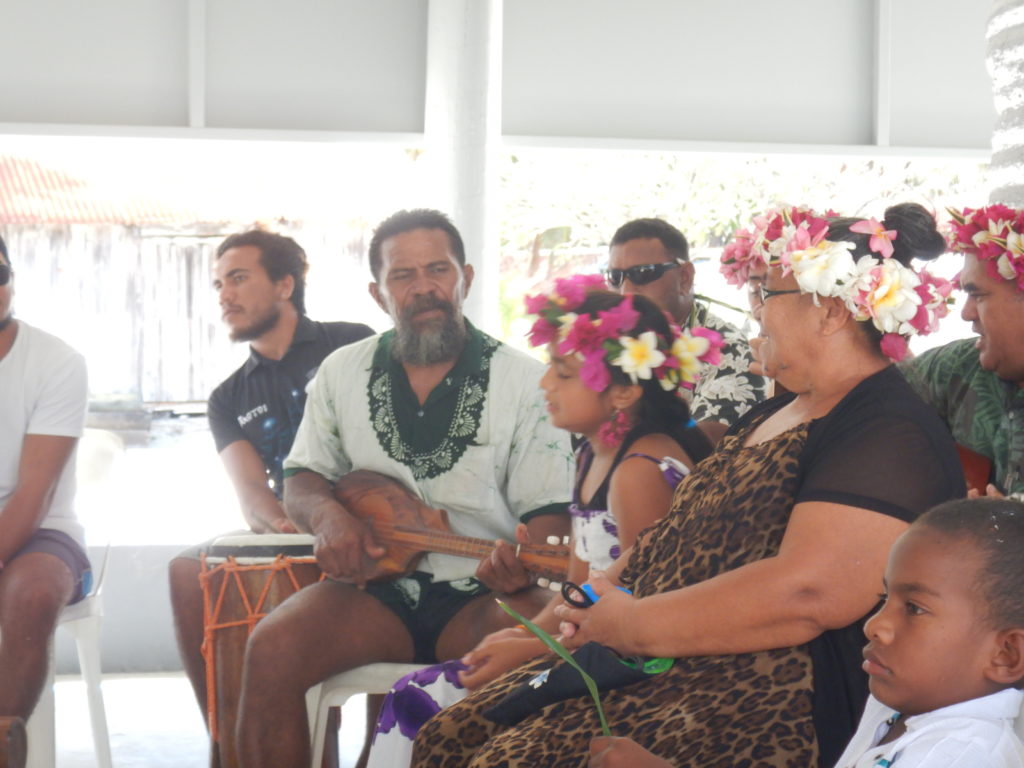
They are very religious and very conservative. Not my cup of tea, of course, but I couldn’t help but think, there are a lot worse ways to grow up. As I sat watching one young teenage boy sing about God and Glory with the passion of Jimmy Hendricks playing the Star Spangled Banner, I thought to myself, well, better this than being off sulking in a corner somewhere smoking crack!

The folks here are very very welcoming to yachties. They treat us like honored guests but not like honkies, if you know what I mean. There is no sense they are after ways to squeeze more money out of us or anything. They sincerely seem interested in sharing their lives with us and are kind and considerate. I also made friends with a little girl who will turn 9 on August 9. Her name is Joy. There are only about 3 kids around her age here. She is so cute a just want to squeeze her! She is learning hula with her aunt and was all dressed up when I first saw her, but later when I saw her playing, I realized they hadn’t knocked the tomboy out of her yet! Her 18 year old Aunt, Juliana, is the other one I have taken a special liking to. She did a gorgeous hula dance at the dancing event, but she is also very good at sports, quite articulate, and very polite. I gave her “Becoming Michelle Obama” – I hope she can relate just a little bit and that it inspires her.

This is a very close-knit family-based community, and everyone is respectful and most seem quite happy. I haven’t heard a harsh word said to another yet. However, I get the impression that there is an undercurrent of an extremely strict patriarchal society. The three family heads, all men, each seem to run a very tight family ship. The kids can’t even leave the house without the fathers asking where they are going. And the kids, even the teenagers, do what the father says, no questions asked. The administrator of the island thinks that such strict controls inhibit creative thinking. I don’t know – I just know that everyone seems very polite.
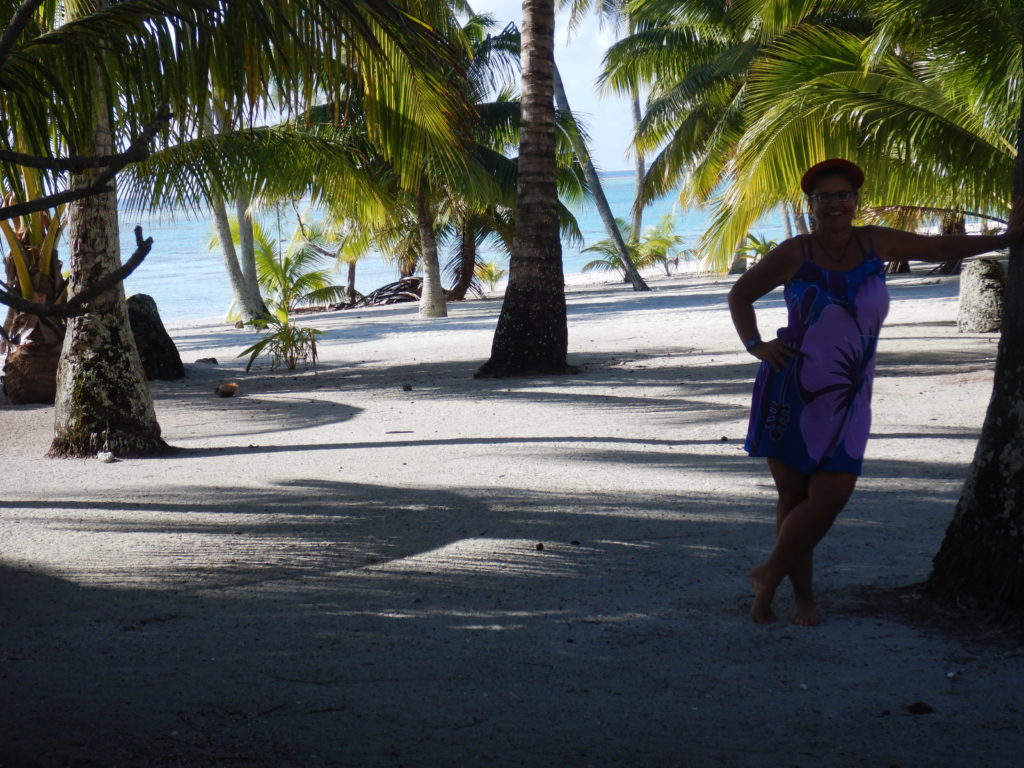
Weather was coming that might make our Palmerston mooring untenable, so off we left for our next destination, Niue.
PALMERSTON TO NIUE, 410 miles
On August 6, we departed for Niue. Our crossing to Niue was exciting. It took us just over three days. Our weather router was all wrong about this crossing: we had 15 hours straight of rain the first night (I felt like I was getting diaper rash from sitting in wet clothes all the time), and sustained winds to 30 knots, gusts to 35, in big seas the second night. We couldn’t set up a RADAR guard zone because all the squalls were constantly setting off alarms. Fortunately, the third night was absolutely idyllic – a bright moon lead our way, the seas were calm, and we could sail wing on wing until about 2 am when we had to motor due to lack of wind. It was perfect.
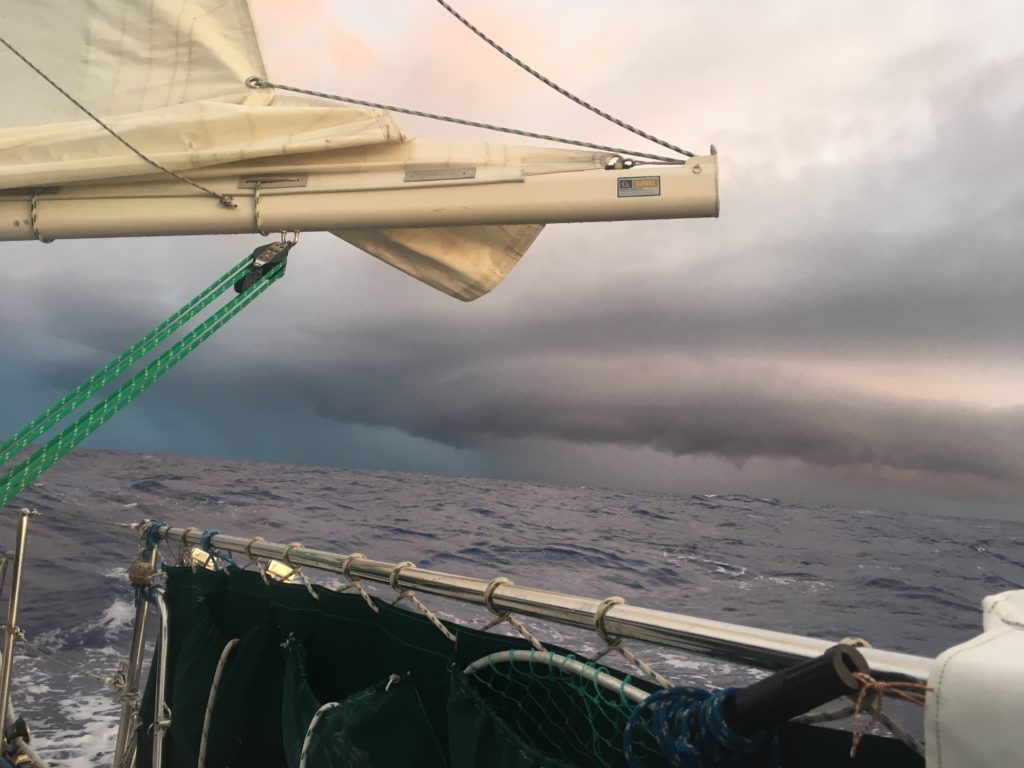
Underway, we had been checking in on SSB (Single Side Band long distance radio) on the HAM Pacific Seafarers Net and on the Polynesian Magellan Net (PolyMagNet for short – twice per day). The HAM station is really reliable. They broadcast from onshore, have relays set up all over the Pacific, can always copy you, never are late or miss a session, and know what to do in case of an emergency. The PolyMagNet in the other hand, are mostly people we know, friendly, and do a good job with emergencies too, but the transmission is only as good as the Net controller’s for the day. They are mostly a local net. Once in Tonga, we will probably switch to another local net as we head west. Rick was handling the morning PolyMagNet and the PacSeaNet check-in, while I was handling the evening PolyMagNet.
So, the first night at sea leaving Palmerston, I am monitoring the PolyMagNet and hear that another boat has broken into the net at the time designated at the start of the net for emergency traffic only. Their boat name was Water Music. They had salt water coming into their boat and they couldn’t find the source. With all of their bilge pumps working at max load full time, they were able to keep the leak from flooding the boat, but that could change at any time.
The net controller promptly contacted the Coast Guard at Papeete, French Polynesia, who then contacted the New Zealand Search and Rescue. Everyone who needed to be was now monitoring Water Music’s location, but no one was physically close enough to get to their boat and rescue them if they were to sink, except … Cool Change!
Yes, we were the closest boat to Water Music (about 100 miles behind) on the passage so we were standing by in case we needed to rescue them! We also copied them better on SSB than anyone else so we did a lot of relaying for them. So that night, instead of getting my nap before my watch, I stayed on the radio with them and they checked in every hour with me and with the New Zealand Search and Rescue. I gave New Zealand our Iridium Go! satellite phone number in case they needed to reach us. Water Music had an Iridum Go! as well, but being one of those sailors who wants his privacy at sea, Water Music’s captain had tucked his satellite phone away in his ditch bag and didn’t have the current phone number. On top of it, Water Music accidentally changed their SSB “mode” when broadcasting so no one heard from them for 24 hours – that put a scare in us all. I actually had New Zealand SAR calling me on our sat phone, asking if we were in touch with Water Music! It was a comedy of errors, if it weren’t so potentially life threatening.
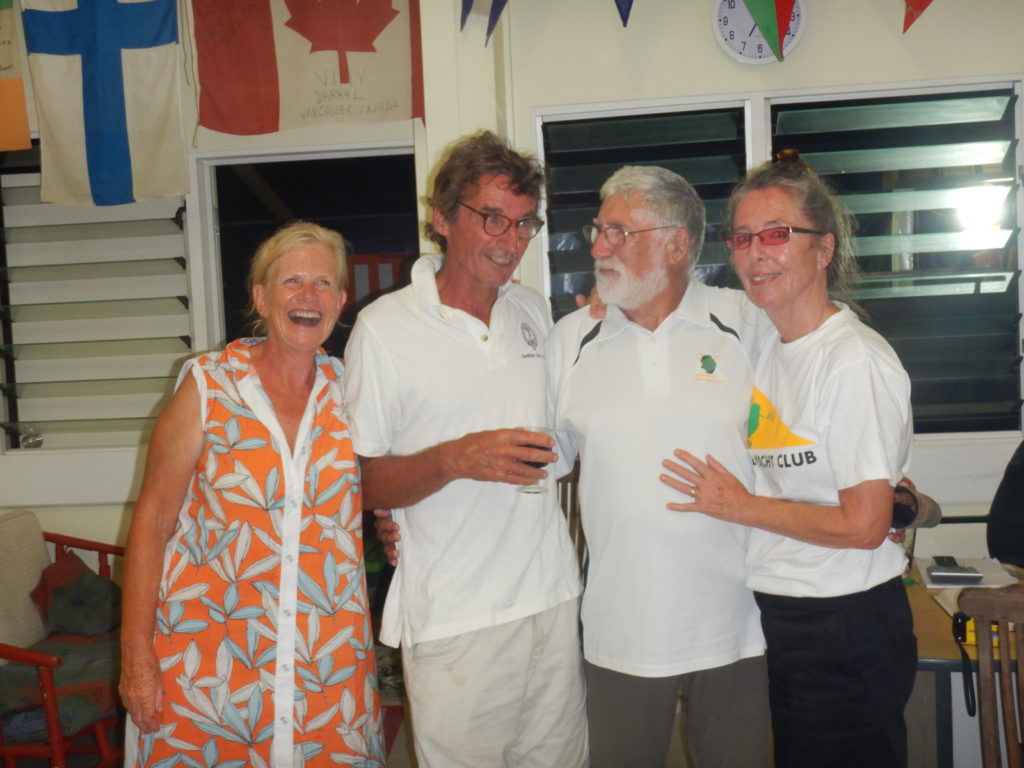
Water Music finally realized they had switched modes, so they switched back and reported in the following day, just 90 miles from Niue. They still had the leak under control but had not found the source yet. Niue Yacht Club had been contacted by several of us and was holding a mooring ball for Water Music, and Niue Search and Rescue was on standby for their evening arrival. Once the boat stopped moving, the leak stopped, and they say their boat rocks forward and aft underway, so they knew the leak had to be either extremely forward or extremely aft. The culprit turned out to be a vent hose for the propane locker – a Jerry can was sitting on top of the hose in a remote locker and wore it through, allowing salt water to ingress through the vent hose into the bilge. A word of caution to us all!
The potential rescue situation with Water Music caused us to ponder on the other boat incidents we had heard about in just the last few weeks in the same region of the South Pacific that we were sailing. As Rick noted, “First there was the boat that crashed on the reef at Aitutaki, Cook Islands. Then we heard of the catamaran who had left Palmerston, arrived Niue, then at some point, crashed on a reef on the east side of the island; it was suspected that the skipper fell asleep. Another incident was a steel sailing vessel named Gwendolyn that was sinking when abandoned en route from Niue to Tonga on August 5. Apparently, it hit a very hard, unknown object and then started sinking quickly. The crew of Gwendolyn was saved, but if their boat didn’t sink completely, we had the chance of hitting it on our next leg.” And not long after all this, a huge pumice field appeared, floating west from Tonga, apparently caused by an underwater eruption. Sailboats who encountered it couldn’t sail around it, couldn’t motor through it, and were slowed down to a slow crawl if they tried to sail through it, with plenty of cosmetic damage in the process. We were grateful when we made it to Niue, and we were grateful that we weren’t going further than Tonga this season.
NIUE
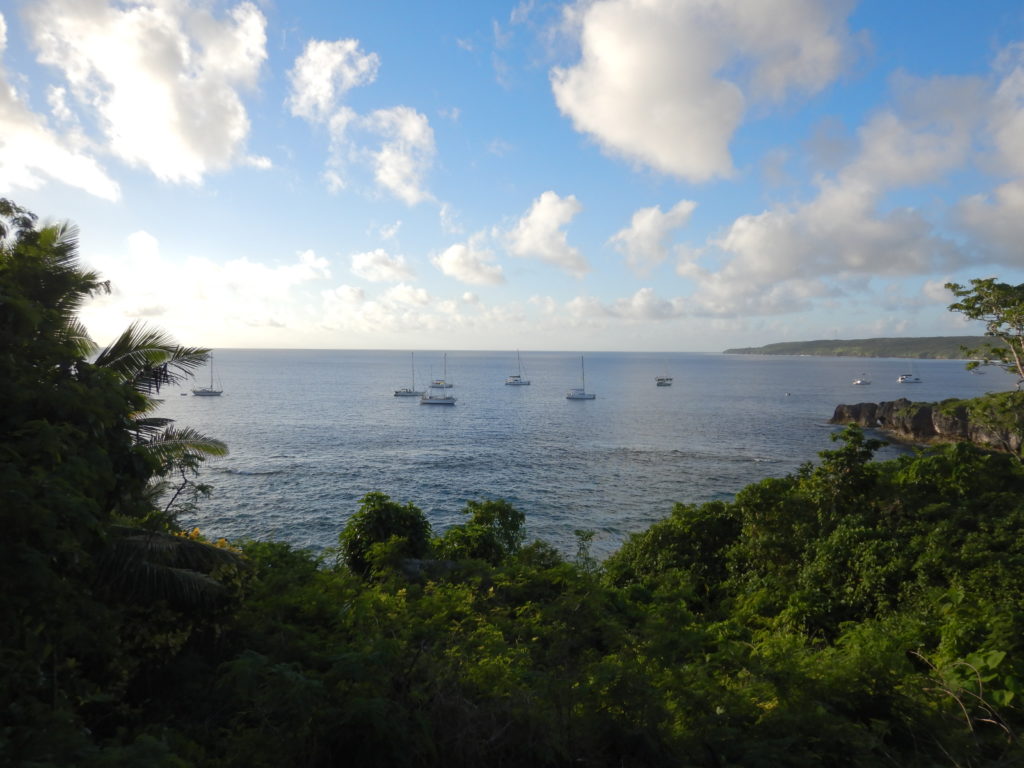
Niue was a dream. It was magical. It is largest “uplifted” atoll in the world, and the smallest sovereign nation in the world. It has low but dense tropical jungle growth all over it that they call “bush,” except where people have cleared to make homes, and its entire shoreline is made up of steep cliffs. They refer to it as the “rock,” except the vegetation is abundant. Huge blue and multicolored “coconut crabs” live in the jungle and come out at night to climb into broken coconuts and eat them. There are only 1200 people who live there.
There is no crime. Everyone really is, honestly, very laid back. To drop off the rental car, we were instructed to leave the car unlocked and place the keys under the visor! I guess no one steals anything because there is no where to take it and everyone knows everyone so the thief would be found anyway!
Driving the car was an experience too. The car rental agent reminded us to drive on the left, “except for potholes!” We learned what he meant when we found ourselves zigzaging all over the road to find a smooth path. The cars do not come equipped with spare tires and it costs $65 to fetch you a new one, if indeed you can even find someone to call for you. We figured the no-spare policy is probably a deterrent to driving fast. The good news is that no one tried to sell us insurance or any other extra costs – sign this form, pay me in cash, here is the car, here are the keys, leave it there when you leave. Period. Oh, and yeah, drive on the left except for potholes.
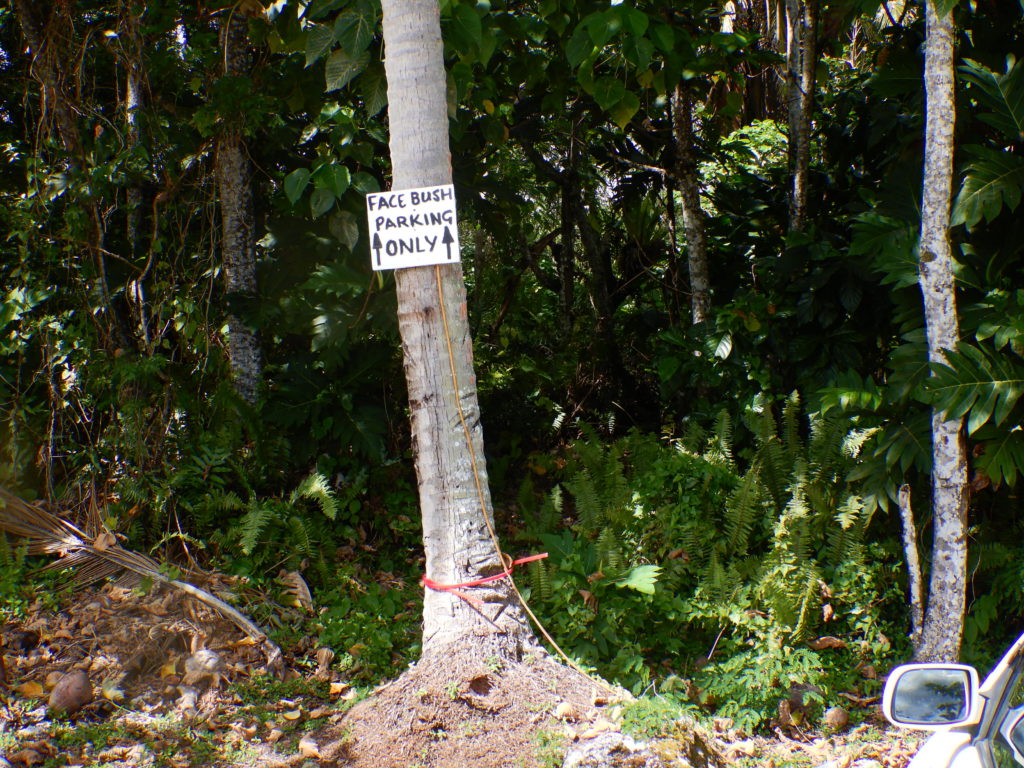

There are only something like 153 “tourist beds” on the entire island, but I think at this time of year, they are mostly full, usually with vacationing New Zealanders. New Zealand supports Niue with small grants, even though Niue is technically independent. But this small tourist population sustains at least five awesome restaurants we went to – a pizza and sushi restaurant owned by an Israeli entrepreneur married to a Niue woman; an East Indian restaurant owned by an East Indian family with authentic food; a cliff side, outdoor restaurant called the “Washaway” on the south side of the island that is open only on Sunday’s, to spite the church goers on the hill above, and serves grilled dishes and lots of beer and wine on a self-serve honor system; another cliff side restaurant in town that is open only for breakfast and lunch; and another restaurant called the Hio Bar up on the north side of the island overlooking the water as well. All are pretty makeshift structures – probably a necessity in a region where cyclones are frequent in season. And these are just the places we have been to. There are others. There is one nice international-type hotel on the island, with pools, a pool bar, etc. – we stopped there for a drink.
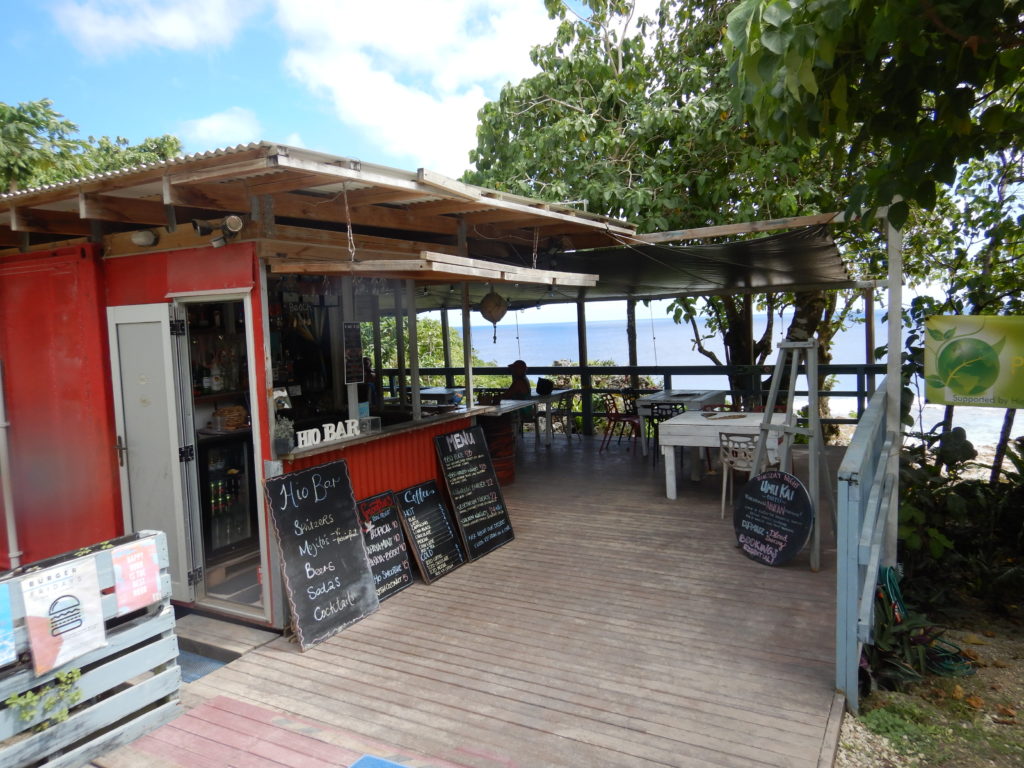
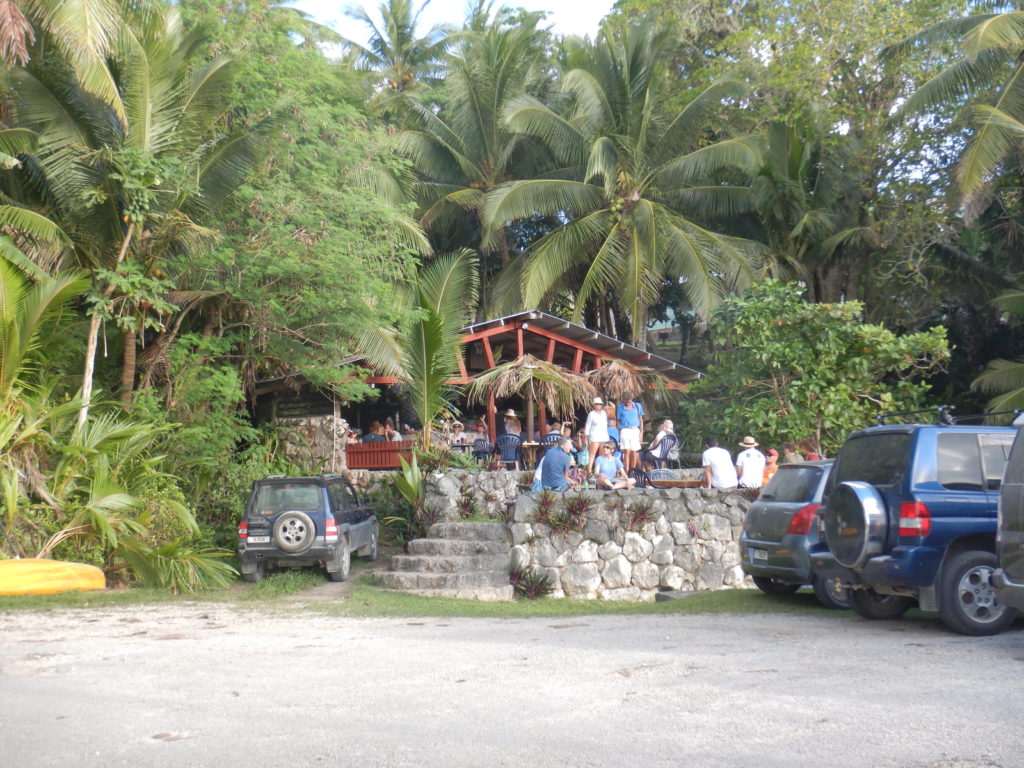

We were lucky enough to arrive for a “show day” at a village on the other side of the island, so we rented a car and got to see traditional game contests like husking coconuts, but also traditional dancing, traditional crafts, good food, etc. They were also competing for the best coconut crab, so that is where we saw a bunch of them, although their treatment seemed kind of cruel. The crabs were tied up on a leash in the hot sun, when usually they are in the shade of the jungle and only come out at night.

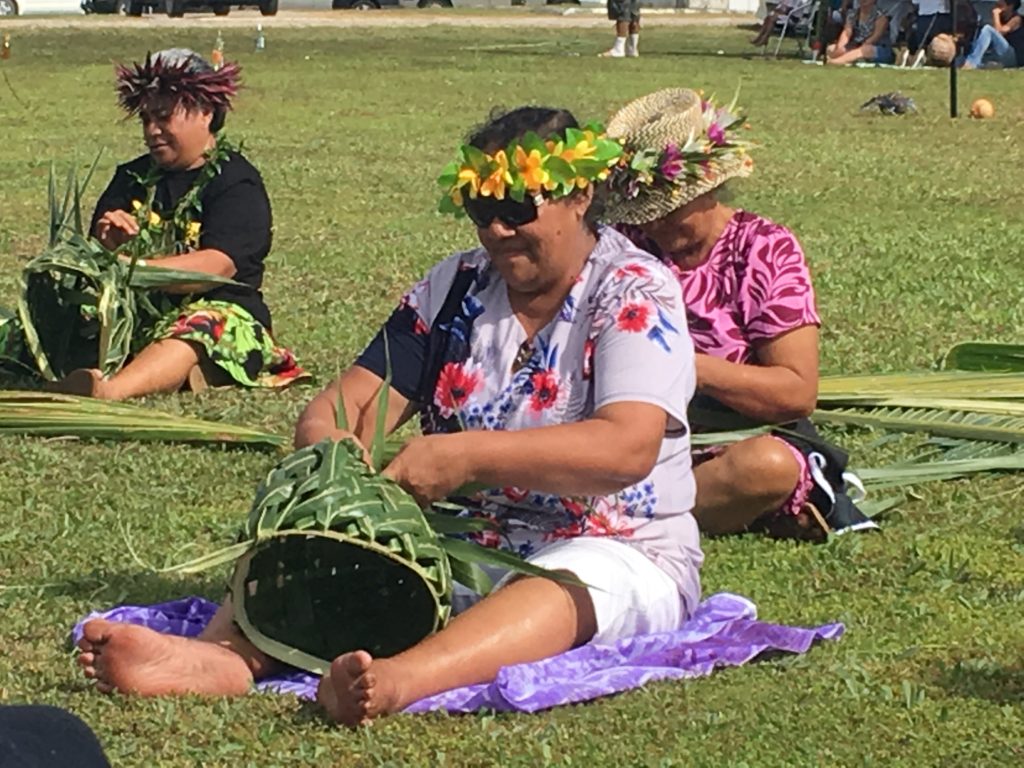
But our favorite part are the ”sea tracks.” The island has done a spectacular job of maintaining access to wonderful caves and hidden pools along the cliffs bordering the sea. They have built stairs, with handrails, and even ropes where needed. I always worry a little about slipping and screwing up a hip, but I felt completely comfortable here. And at the exit, there was almost always a flush toilet and a shower! All for free. I was hoping to rent a car one more day and go back and see some more, but I managed to get hit by a cold virus on our third day, and was laid up for the rest of the time on Niue.


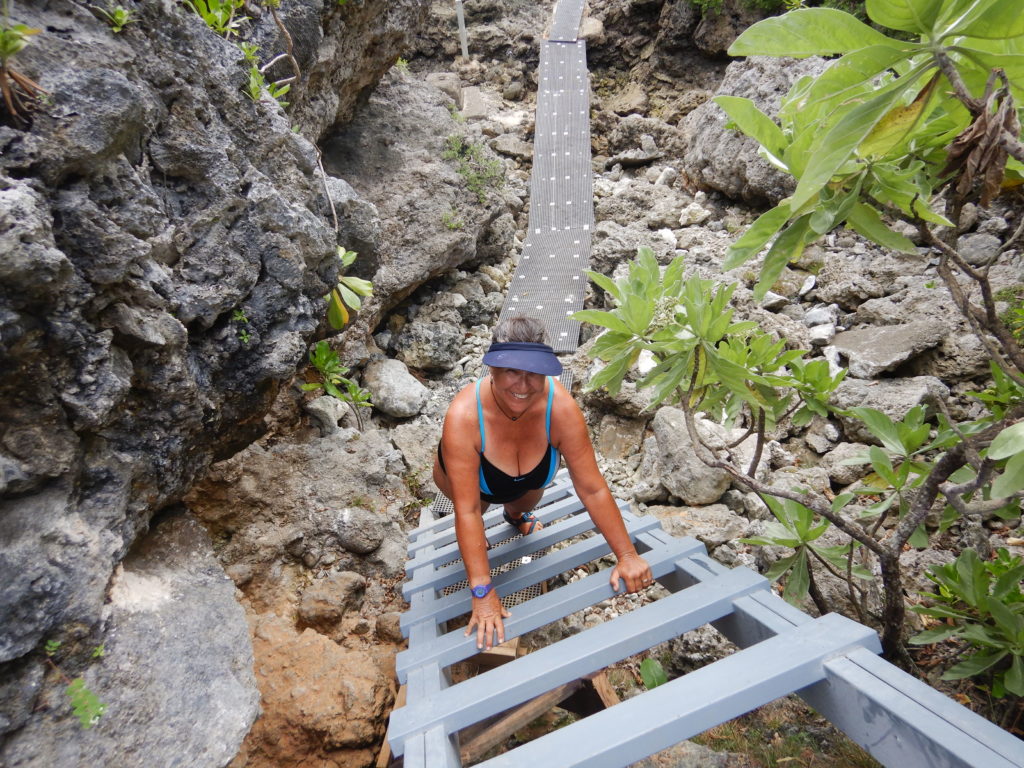
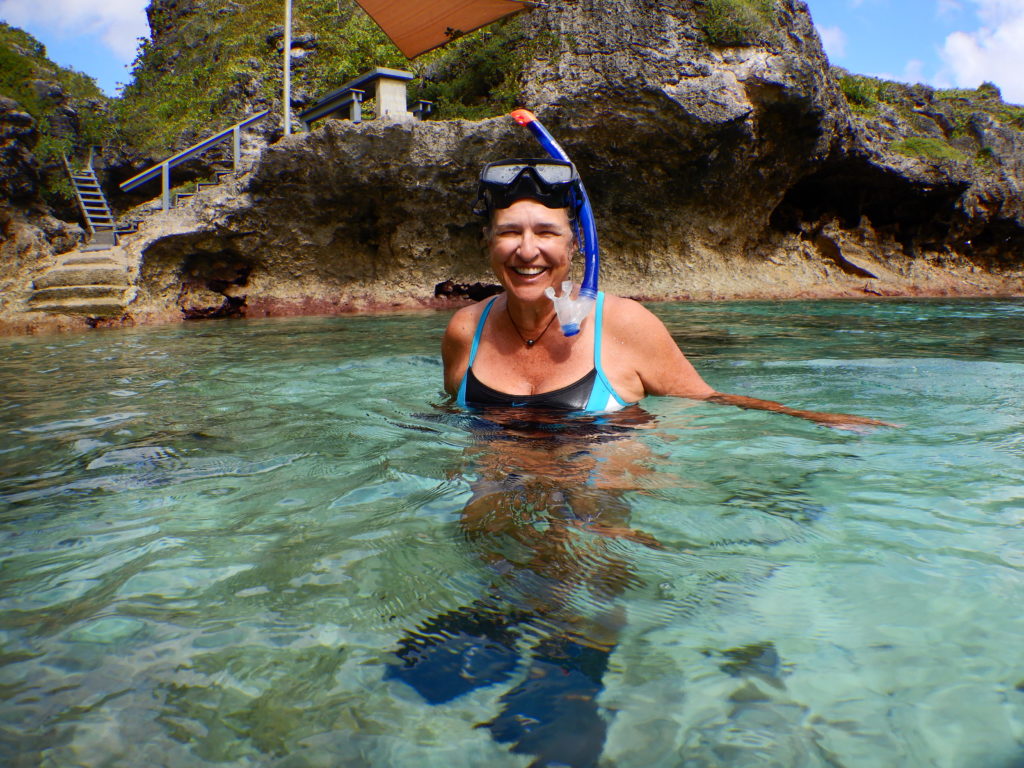
One of the most unusual features of Niue from a cruising perspective is the dinghy launch. There is no beach to dinghy up to, so instead, you dinghy up to a cement wall and haul your dinghy up via a lift. You have to rig a three-point lift onto your dinghy ahead of time, which we did in Bora. Here are two videos partially showing the lift. It is operated by simple up-down buttons and anyone can use it. Rick put our dinghy wheels on to make it easier to move, but they have a dinghy cart available so the wheels aren’t necessary.
Sadly, like Palmerston, we had to leave Niue to avoid westerly winds that would have made the mooring field untenable. As we were leaving, I was just getting over the most delirious part of my cold virus and Rick was just coming down with it.
NIUE TO TONGA, 260 miles
Leaving on August 15, this was the mellowest of our crossings to Tonga. Some of the time we had to motor, or as often as not we were able to sail Wing on Wing because the seas were flat enough to not make the yawing excessive.
The trip started out exceptionally well for Rick and not so much for me. Rick wanted to leave by 4 am to arrive in daylight in case our journey was exceptionally slow, but he accidentally set the alarm to leave at 3 am instead. As he was motoring out of the mooring field, whales breached right next to the boat and then gave him a tail show as they dove into the depths, moonlight silhouetting their outlines. He said it was glorious, enough to take your breath away.
Meanwhile, the distance calculations did not justify an early departure in my mind, and I am not an early morning person. Waking at 0230 meant adding a night to the voyage, from my perspective. The only way I was persuaded to agree to it was that I was promised I could go back to sleep the moment we left the mooring field. I will never be persuaded by that argument again! The wind was light but rather than being content with motoring until dawn broke and I was up, Rick grasped at every straw of a momentary increase in wind velocity to put up the sails and turn off the engine, and then, moments later, his hopes were dashed as the wind fell below sailable velocity again, so he doused the sails and turned the motor on again. This happened three times in three hours – there was no way I was sleeping through all that racket!
As it turned out, rather than being concerned about arriving after nightfall, we found ourselves concerned about arriving before daybreak, so we had to slow down as we approached Tonga. The size of the swell picked up a little during the course of our crossing, but the period was so great (about 17 seconds) that it barely felt like a swell at all. As we rounded the northern tip of the Vava’u island group in Tonga, our course changed to a beam reach, so even though the wind hadn’t picked up much, we were going faster. But then as we made our final approach to the western entrance of the group, we found ourselves with 20 knots on the nose, and that slowed us down a lot.
We arrived at a mooring ball in the Bay of Refuge in Neiafu, Tonga early Sunday morning, August 18. Although the passage was only two days, we arrived three days later because we crossed the International Date Line and lost a day. I am still figuring out how that works! If I make a telephone appointment for Monday in the US, does that mean my appointment is on Tuesday here? I think so. But it is a little baffling to be reminded that time is just a human construct.
TONGA

Meanwhile, we have only scratched the surface of Vavau, Tonga. There are 42 numbered anchorages amongst 61 separate islands in the Vava’u group alone, and there are three island groups. The Vava’u group is considered a top worldwide cruising ground, partly made so accessible thanks to the Moorings Charter Company, that has done a lot to promote the anchorage information and make services available. We chose it because there is a boatyard here that will haul out our boat and secure it for cyclone season while we fly home. We have visited the boatyard and are quite impressed.
The principal town of Neiafu is designed for cruisers. There is a coffee shop owner who is devoted to providing all of the necessities cruisers have, like laundry, internet and a good, large cup of coffee. There is an over-the-water restaurant with good food and drinks that makes their large dinghy dock available for free to anyone, regardless if they are eating at the restaurant or not. And there are plenty of moorings set in the deep bay which are maintained by one of the local dive shops. The prices tend to be more reasonable than French Polynesia although they still,don’t compare to Mexico. The customs and immigration officials for clearing into the country mostly tended to be honest and efficient, although one did ask us for a gift of tobacco and fish hooks!
But the real jewels of Vava’a, we have yet to explore: the caves that you dive under to get to, the lake you sail to inside the crater of a volcano, the magnificent snorkeling opportunities, and the chance to swim with humpback whales. More to come … stand by.

Really enjoyed reading your blog…what an adventure you two are having..and fabulous memories you’ll always treasure….well maybe not all!…Thanks for sharing
What an amazing voyage that is beautifully told! The rewards must be amazing for all that you have endured. Miss seeing you on the river though.
Hi guys!
My name’s Dominic, I’m Ken Swoyer’s son-in-law – he introduced me to your blog about a year ago i think..!? Loving reading your posts, and following your adventures. I spent 4 years crewing aboard various large motor yachts (‘stinkpots’!) 25 years ago, throughout the med & Caribbean. I’m from Portsmouth UK, and am an equally avid lover of the water, esp. the ocean. Sailing the South Pacific is a dream I intend to make come true one day (we currently have an 11 & 8-year-old, so we’re a little behind you..!). Anyway – hi! – and I wanted to send you this link to a BBC article on the pumice field you mentioned – it was a the most-0read article on the BBC for a day or so! Hope you can see the vid. And safe & happy sailing..!
https://www.bbc.com/news/world-australia-49469446
Hi Rick and Cindy. We met at the Tongan Beach Resort before dinner. I asked the question how to best counter weather helming.
I checked out your great blog site as well. I have been a skipper for a while but if you do a search of STS-123 you will see why I never used sails on my favorite ship!
We wish you were travels in the future. We arrived home to Colorado in a blizzard yesterday. A cool change for sure.
All the best.
Dom Gorie